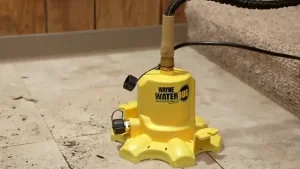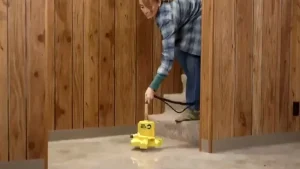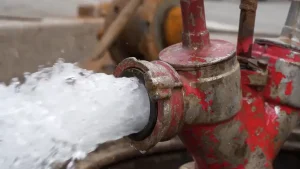A 1/3 HP sump pump is less powerful than a 1/2 HP pump, offering lower water displacement capabilities. The 1/2 HP pump can move more water and handle higher lifts.
Choosing the right sump pump depends on your specific needs, such as the size of the area to be drained and the volume of water to manage. A 1/3 HP sump pump is typically sufficient for smaller homes with less frequent water issues.
It is more energy-efficient and costs less to operate. On the other hand, a 1/2 HP sump pump is better suited for larger spaces or higher water tables. It can pump out water more quickly, making it ideal for areas prone to heavy rainfall or flooding. Selecting the appropriate horsepower ensures reliable protection against water damage, enhancing the longevity of your property’s foundation and basement.

Power Comparison
When choosing a sump pump, power is a key factor. The debate between 1/3 hp vs 1/2 hp sump pump specs often comes up. Each has its own merits. Let’s dive into the power comparison to see which might be right for your needs.
Performance Differences
The performance of a sump pump is critical in keeping your basement dry. Here’s what you need to know about the two types:
- 1/3 HP Sump Pump: Suitable for most average-sized homes with a normal water table.
- 1/2 HP Sump Pump: Better for larger homes, high water tables, or significant rainfall.
The 1/2 hp sump pump stands out in its ability to handle more water. It can push water horizontally a greater distance. This is essential if the water needs to travel far from your home.
| Feature | 1/3 HP Sump Pump | 1/2 HP Sump Pump |
|---|---|---|
| Water Volume | Less volume | More volume |
| Distance | Shorter distance | Longer distance |
For instance, how far can a 1/2 hp sump pump push water horizontally? It can typically move water several hundred feet. This is beyond the capabilities of a 1/3 HP model.
Energy Consumption
Energy use is also a big part of the power comparison. Let’s break it down:
- 1/3 HP Sump Pump: Consumes less power, leading to lower electricity bills.
- 1/2 HP Sump Pump: Uses more energy but offers greater pumping power.
Here’s a simple overview of their energy usage:
| Model | Energy Use |
|---|---|
| 1/3 HP Sump Pump | Lower |
| 1/2 HP Sump Pump | Higher |
Although the 1/2 HP sump pump uses more energy, it may be necessary for certain situations. Always weigh the potential for higher energy costs against the need for a more powerful pump.
Pump Capacity
Understanding the differences between a 1/3 HP and a 1/2 HP sump pump is critical for ensuring your basement remains dry. The pump capacity, which includes factors like flow rate and height of discharge, determines how effectively a pump can remove water. A proper sump pump size calculator can provide a clearer picture, but let’s delve into the specifics to make an informed decision.

Flow Rate
The flow rate of a sump pump measures how much water it can move within a certain timeframe. It’s typically measured in gallons per minute (GPM) or gallons per hour (GPH). The flow rate depends on the motor’s horsepower (HP) and the efficiency of the pump. A 1/3 HP pump might suffice for a home with an average water table and less intense flooding. However, a 1/2 HP pump can tackle higher volumes of water, making it suitable for areas prone to heavy rainfall or higher water tables.
Below are some key points to consider:
- A 1/3 HP sump pump is generally adequate for smaller volumes of water and normal soil saturation.
- A 1/2 HP sump pump excels in areas with rapid water accumulation, offering a higher flow rate.
For a more precise determination, use a sump pump size calculator. This tool takes into account your specific situation to recommend the ideal HP for your sump pump.
Height Of Discharge
The height of discharge, also known as head height, is the vertical distance water must be lifted from the sump pit to the point of discharge outside your home. The 1/3 HP and 1/2 HP sump pumps differ significantly in this aspect. The 1/2 HP pump generally has a higher maximum head height, meaning it can push water up to a greater elevation. Here’s why this is important:
- Taller basements and foundations require a pump with a higher head height capability.
- Longer horizontal discharge distances also benefit from a more powerful pump to ensure efficient water ejection.
It’s essential to check the manufacturer’s specifications for the maximum head height and match it with your home’s requirements. A sump pump size calculator can assist in determining the necessary head height, ensuring you select a sump pump that won’t falter when it’s needed most.
Applications
When it comes to keeping basements dry and protecting homes from flooding, choosing the right sump pump is key. The battle between 1/3 HP and 1/2 HP sump pumps revolves around power, efficiency, and suitable applications. Let’s dive into how each type serves different settings, from cozy homes to bustling commercial spaces.
Residential Use
For most homes, a sump pump stands as the first line of defense against water damage. The choice between 1/3 HP and 1/2 HP pumps often depends on the size of the area and the volume of water to manage. Consider the following points:
- 1/3 HP Sump Pumps: Ideal for average-sized homes with moderate water tables. They consume less energy, making them cost-effective for regular use.
- 1/2 HP Sump Pumps: Suited for larger homes or those in areas with higher water tables. They offer more power to move water quickly, great for heavy-duty needs.
Here’s a quick comparison:
| Feature | 1/3 HP Pump | 1/2 HP Pump |
|---|---|---|
| Water Volume | Good for average water volume | Handles high water volume |
| Energy Use | Lower energy consumption | Higher energy use |
| Cost | More budget-friendly | Higher upfront cost but provides more power |
For a small to medium basement with occasional water build-up, a 1/3 HP pump is often enough. Larger homes with frequent flooding might need the extra power of a 1/2 HP pump.
Commercial Use
In commercial settings, the stakes are higher when it comes to water damage. The right pump must handle not just more water but also run longer and more frequently. Let’s break down the applications:
- 1/3 HP Sump Pumps: Suitable for small businesses with less foot traffic and lower risk of water intrusion. They work well in smaller spaces like utility rooms or basements.
- 1/2 HP Sump Pumps: The go-to option for larger commercial spaces such as warehouses, manufacturing plants, or retail stores with higher water management needs.
Consider this comparison:
| Feature | 1/3 HP Pump | 1/2 HP Pump |
|---|---|---|
| Durability | Reliable for light to moderate use | Built for heavy, continuous use |
| Performance | Efficient for smaller volumes of water | Powerful performance for large volumes |
| Cost-Efficiency | More economical for low-risk areas | Better long-term investment for high-risk zones |
In businesses where downtime equals lost revenue, a 1/2 HP sump pump often offers the reliability and performance needed. Smaller enterprises might find a 1/3 HP pump to be a smart, cost-effective choice.
Cost Analysis
Choosing between a 1/3 hp and a 1/2 hp sump pump is crucial for keeping basements dry. Each option has its own cost implications. Let’s dive into a cost analysis to help you decide.
Initial Investment
When picking between a 1/3 hp and a 1/2 hp sump pump, the initial cost is a big factor. Generally, 1/3 hp pumps are cheaper. They’re good for smaller homes with less water to manage. 1/2 hp pumps cost more but handle more water. They suit larger homes or areas with high water tables. Here’s a breakdown:
- 1/3 hp sump pump: Great for less water.
- 1/2 hp sump pump: Best for more water.
| Type | Cost Range |
|---|---|
| 1/3 hp Sump Pump | $100 – $200 |
| 1/2 hp Sump Pump | $150 – $300 |
This table shows the 1 3 hp vs 1 2 hp sump pump cost range. Choose based on your home’s size and water level.
Maintenance Costs
Maintenance keeps pumps running well. 1/3 hp pumps usually cost less to maintain. They’re simpler and have fewer parts. 1/2 hp pumps might need more upkeep due to their complexity. Both types need regular checks. Here’s what you might pay for maintenance:
- Checking the pump: Important for all pumps.
- Cleaning the pump: Keeps it working smoothly.
Expect these maintenance costs:
- 1/3 hp pump: Lower maintenance costs.
- 1/2 hp pump: Higher maintenance costs, but handles more water.
A well-maintained pump lasts longer. This reduces the need for costly replacements. The right choice balances initial cost and maintenance. Think about your home’s needs before deciding.

Installation Process
Choosing the right sump pump is crucial for keeping your basement dry and your home safe from water damage. The debate between a 1/3 HP and a 1/2 HP sump pump often comes down to the size of your home and the amount of water you need to move. Once you’ve selected the best fit, the next step is installation. A smooth installation process ensures your pump runs efficiently. Let’s dive into the tools you’ll need and a simple guide to help you set up your new sump pump.
Tools Required
Before you start the installation of your sump pump, gather all the necessary tools to make the process seamless. You’ll need:
- Drill with various bits
- Hacksaw for cutting pipes
- Pliers and adjustable wrenches
- PVC primer and cement for secure pipe fittings
- Tape measure to ensure correct placement
- Wire strippers and electrical tape for wiring tasks
- Check valve to prevent backflow
- Teflon tape to seal threaded joints
With these tools at hand, you are now ready to install your sump pump. Ensure you have a clean workspace and all your tools are in good condition.
Step-by-step Guide
Installing your sump pump is a straightforward process. Follow this step-by-step guide:
- Start by clearing the sump pit. Remove any debris that could clog your pump.
- Place the pump into the pit, making sure it sits level on the bottom.
- Measure and cut the PVC discharge pipe to fit from the pump to the exit point outside your home.
- Use PVC primer and cement to attach the pipe securely to the pump.
- Install the check valve on the discharge pipe to prevent water from flowing back into the pit.
- Drill a relief hole in the discharge pipe below the check valve to prevent air lock.
- Connect the pump’s electrical cord to a GFCI outlet. Avoid using extension cords.
- Test the pump by pouring water into the pit to raise the float switch.
Remember to check your pump’s manual for any specific instructions. Regular maintenance will keep your pump running smoothly for years to come.
Durability Factors
Choosing the right sump pump can be a game-changer for keeping your basement dry. When comparing 1/3 HP and 1/2 HP sump pumps, understanding durability factors is crucial. These factors help determine how long your pump will last and how well it will perform. Let’s dive into the material quality and lifespan expectations of these pumps.
Material Quality
The materials used in a sump pump directly affect its durability and performance. Both 1/3 HP and 1/2 HP pumps come in various builds, from plastic to cast iron. Cast iron pumps are generally more robust and provide better heat dissipation. In contrast, plastic models are more affordable but may not withstand harsh conditions as well. Consider the environment where the pump will operate. For damp and potentially corrosive spaces, a pump with a stainless steel exterior might offer the best longevity.
- Cast Iron – Great for heat dissipation, heavy-duty.
- Plastic – Cost-effective, lighter, less durable.
- Stainless Steel – Resistant to corrosion, long-lasting.
You have to remember, the material quality also impacts the pump’s ability to resist wear and tear from debris and sediment. A well-constructed pump with a solid, debris-resistant impeller will likely last longer.
Lifespan Expectations
Lifespan is a key factor when comparing 1/3 HP and 1/2 HP sump pumps. Typically, a 1/2 HP pump has a longer lifespan due to its ability to handle higher volumes of water, reducing strain. A 1/3 HP pump, while efficient for smaller volumes, may work harder in the same conditions. This extra effort can shorten its lifespan.
Consider these points for lifespan expectations:
- Maintenance – Regular checks can extend a pump’s life.
- Usage Frequency – Less frequent use can lead to a longer lifespan.
- Quality of Components – Higher quality parts result in longer performance.
Manufacturers often provide an estimated lifespan, but real-world conditions play a significant role. The following table illustrates typical lifespan ranges:
| Pump Type | Estimated Lifespan |
|---|---|
| 1/3 HP Sump Pump | 5-7 years |
| 1/2 HP Sump Pump | 7-10 years |
A 1/2 HP pump often outlasts a 1/3 HP model, but proper care can bridge the gap. Ensure you follow the manufacturer’s guidelines for both types to maximize their lifespan.
User Reviews
Choosing between a 1/3 HP and a 1/2 HP sump pump can be tricky. Both are popular, but user reviews shed light on which might be best for your home. Let’s dive into what users say about their experiences and what experts recommend.
Customer Experiences
Many homeowners have shared their thoughts on 1/3 HP vs 1/2 HP sump pumps. Their feedback is invaluable for anyone trying to decide. Here’s a summary of what they say:
- 1/3 HP Sump Pumps are great for smaller homes with average water levels. They are more affordable and consume less energy.
- 1/2 HP Sump Pumps, on the other hand, offer more power. They are ideal for larger homes or areas with high water tables. These pumps can handle more water and provide extra peace of mind during heavy rainfalls.
| Feature | 1/3 HP Sump Pump | 1/2 HP Sump Pump |
|---|---|---|
| Power | Good for average water levels | Handles high water levels |
| Cost | More affordable | Higher upfront cost |
| Energy Use | Less | More |
Overall, users suggest considering your home’s size and water levels before choosing. They also recommend looking for pumps with good warranties and customer support.
Expert Opinions
Experts in home maintenance and waterproofing have their own take on the 1/3 HP vs 1/2 HP sump pump debate. Here’s what they say:
- Experts agree that 1/3 HP pumps work well for most average-sized homes. They are cost-effective and efficient for typical use.
- For homes in areas prone to flooding or with higher water tables, 1/2 HP pumps are recommended. They provide extra power and reliability in demanding situations.
Experts also highlight the importance of proper installation and regular maintenance. They suggest choosing pumps with solid construction and reliable performance over time. Moreover, they recommend consulting with a professional before making a decision, to ensure the pump meets the specific needs of your home.
In summary, both user experiences and expert opinions offer valuable insights into choosing the right sump pump. Whether it’s the affordability and efficiency of a 1/3 HP pump or the power and reliability of a 1/2 HP pump, the best choice depends on your home’s specific requirements.
Future Trends
When thinking about a sump pump for your basement, you might wonder about the difference between a 1/3 HP and a 1/2 HP model. As we look forward, innovation and market trends shape the choices we make for our homes. Let’s dive into what the future holds for these essential home appliances.
Technological Advancements
The world of sump pumps is witnessing exciting technological leaps. Smart technology integration is a game-changer, with pumps now able to alert homeowners to potential issues via smartphone apps. This means less worry and more control over basement flooding risks. Here’s what’s on the horizon:
- Energy Efficiency: New models boast better energy use, saving money and the planet.
- Material Innovation: Corrosion-resistant materials are extending pump life significantly.
- Automatic Functionality: Pumps can now detect water levels and turn on without human intervention.
As for power, we see a trend towards more efficient motors that provide the same pumping capacity while using less electricity. The table below outlines the potential improvements expected:
| Feature | 1/3 HP | 1/2 HP |
|---|---|---|
| Energy Use | Decrease by 10% | Decrease by 15% |
| Lifespan | Increase by 20% | Increase by 25% |
| Smart Features | Addition of Wi-Fi Connectivity | Addition of Wi-Fi and Automation |
These upgrades mean that choosing between a 1/3 HP and a 1/2 HP pump is not just about power but also about the overall features that come with it.
Market Predictions
The market for sump pumps is set to grow steadily. With climate change causing more extreme weather patterns, the demand for reliable home protection is on the rise. Here’s what experts predict:
- Increased Demand: More homes will need sump pumps as flooding becomes common.
- Customization: Pumps will cater to specific home needs, with more options for size and power.
- Regulatory Standards: Stricter codes will push for higher quality and safer pumps.
Considering the 1/3 HP and 1/2 HP models, the focus will be on versatility and adaptability. Manufacturers are likely to produce pumps that fit a variety of home types. This means more choices for homeowners. The following points highlight expected market changes:
- Market Share: 1/2 HP pumps may see a rise in popularity due to increased power needs.
- Price Points: As technology becomes standard, prices for advanced features may drop.
- Consumer Awareness: Education on the importance of sump pumps will lead to informed decisions.
Now the market is moving towards smarter, more efficient sump pumps that offer peace of mind and cost savings. Whether you opt for a 1/3 HP or a 1/2 HP pump, the future looks bright for keeping basements dry and secure.

F A Q for 1 3 Hp Vs 1 2 Hp Sump Pump
Choosing the right sump pump can be a bit puzzling. Especially when deciding between a 1/3 HP and a 1/2 HP sump pump. These two are among the most common choices for residential use. To help clear any confusion, we’ve compiled a list of frequently asked questions. They touch on important aspects such as water pumping capacity, horsepower benefits, pump power, and longevity. Let’s dive into the specifics and shed some light on the 1/3 HP vs 1/2 HP sump pump debate.
How Far Can A 1/3 Hp Sump Pump Pump Water?
A 1/3 HP sump pump typically has the ability to pump water several feet high. The exact distance depends on the model and the head pressure. But on average, it can manage a vertical lift of up to 25 feet.
Is A Higher Hp Sump Pump Better?
Not necessarily. While a higher HP sump pump can pump more water and handle higher head pressures, it’s crucial to match the pump to your specific needs. An oversized pump can cycle too frequently, leading to early wear.
Can A Sump Pump Be Too Powerful?
Yes, a sump pump can indeed be too powerful for a given situation. If it’s too strong, it will short-cycle, turning on and off rapidly. This can reduce the pump’s lifespan and waste energy.
How Long Does A 1/3 Hp Sump Pump Last?
The lifespan of a 1/3 HP sump pump varies based on usage, maintenance, and quality. Generally, it can last between 5 to 10 years. Regular maintenance can help extend its service life.
Conclusion
You have to choose between a 1/3 HP and 1/2 HP sump pump depends on your specific needs. Consider factors like the size of your space and water level issues. A 1/2 HP pump offers more power, ideal for larger areas. For smaller spaces, a 1/3 HP pump suffices, ensuring efficiency and cost-effectiveness.
Make an informed decision to protect your property effectively.
